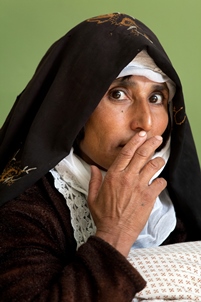 Zubaida, a TB patient who sought care at the Herat TB centre in western Afghanistan. Photo credit: WHO/Laura SalvinelliEarly diagnosis and quality treatment are crucial in the fight against the disease
Zubaida, a TB patient who sought care at the Herat TB centre in western Afghanistan. Photo credit: WHO/Laura SalvinelliEarly diagnosis and quality treatment are crucial in the fight against the disease
Kabul 24 March 2015 – World Tuberculosis Day is celebrated today around the world to raise awareness and call for more effective measures to combat tuberculosis (TB), one of the world’s top infectious killers. Afghanistan is among the 22 countries in the world that suffer from a high burden of tuberculosis – around 13 000 Afghans die each year because of the disease. Globally in 2013, 9 million people fell ill with TB and 1.5 million lost their lives.
“Too many people in Afghanistan die every year because of tuberculosis which is a completely preventable and curable disease,” said Dr Firozuddin Feroz, Minister of Public Health of Afghanistan. “The Government is committed to ensuring that each and every Afghan has access to quality TB services and medicines and that people are better informed about the disease, its causes and symptoms so they know to seek care when needed. We need to also fight the stigma associated with TB.”
In 2014, there were an estimated 58 000 new tuberculosis cases in Afghanistan, out of which 56% were diagnosed and provided a 6-month treatment course. However, more than 25 000 were missed by the health system. Those most at risk for contracting tuberculosis include women and children, poor and malnourished people, refugees and internally displaced persons and the elderly. Women in Afghanistan are particularly vulnerable to the disease as they constitute two thirds of all TB patients.
Multidrug-resistant tuberculosis, caused mainly by poor management and treatment of regular TB cases by low quality medicine, has emerged as a serious challenge for Afghanistan. “Last year more than 1200 people developed multidrug-resistant tuberculosis in Afghanistan. This is a serious issue and we need to do much more to reverse this trend, to strengthen screening and testing, treatment and follow-up,” said Dr Rik Peeperkorn, WHO Country Representative.
“It is unacceptable that many tuberculosis cases go undiagnosed, untreated or are not cured. WHO is committed to continuing its support to the Government of Afghanistan to make sure everyone has access to information, good-quality medicines and services,” said Dr Peeperkorn. “Nobody should be left behind in the fight against TB. We need to accelerate progress towards zero TB deaths, infections, suffering and stigma.”
What is tuberculosis and how can it be treated?
Tuberculosis is an infectious disease most often affecting the lungs. When people with pulmonary TB cough, they propel TB germs into the air. The symptoms of active pulmonary TB include cough (sometimes with sputum or blood), fatigue, loss of appetite, weight loss, fever, chills and night sweats. Tuberculosis is treatable with a 6-month course of antibiotics and the vast majority of TB cases can be cured when medicines are provided and taken properly. Without treatment, mortality rates are high, and through blood flow TB can spread to other parts of the body, including bones, brains and kidneys.
###
For more information, please contact:
Mohammad Ismail “ Kawusi”
Ministry of Public Health
Phone: +93792 88 88 55
email:
Dr Reza Aloudal
Tuberculosis Programme Manager
World Health Organization
email:
Phone: +93 782 200 389


